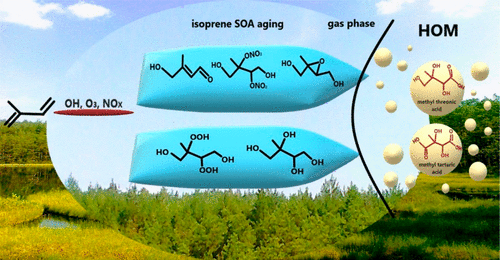Organic Hydroxy Acids as Highly Oxygenated Molecular (HOM) Tracers for Aged Isoprene Aerosol
Mohammed Jaoui, Rafal Szmigielski, Klara Nestorowicz, Agata Kolodziejczyk, Kumar Sarang, Krzysztof J. Rudzinski, Anna Konopka, Ewa Bulska, Michael Lewandowski, and Tadeusz E. Kleindienst
Environ. Sci. Technol. (2019) 53,14516−14527
Abstract
 Highly oxygenated molecules (HOMs) are a class of compounds associated with secondary organic aerosols exhibiting high oxygen to carbon (O:C) ratios and often originating from the oxidation of biogenic compounds. Here, the photooxidation and ozonolysis of isoprene were examined under a range of conditions to identify HOM tracers for aged isoprene aerosol. The HOM tracers were identified as silylated derivatives by gas chromatography−mass spectrometry and by detecting their parent compounds by liquid chromatography−high resolution mass spectrometry. In addition to the previously observed methyltetrols and 2-methylglyceric acid, seven tracer compounds were identified, including 2-methyltartronic acid (MTtA), 2-methylerythronic acid (2MeTrA), 3-methylerythronic acid (3MeTrA), 2-methylthreonic acid (2MTrA), 3-methylthreonic acid (3MTrA), erythro-methyltartaric acid (e-MTA), and threo-methyltartaric acid (t-MTA). The molecular structures were confirmed with authentic standards synthesized in the laboratory. The presence of some of these HOMs in the gas and particle phases simultaneously provides evidence of their gas/particle partitioning. To determine the contributions of aged isoprene products to ambient aerosols, we analyzed ambient PM2.5 samples collected in the southeastern United States in summer 2003 and at two European monitoring stations located in Zielonka and Godów (Poland). Our findings show that methyltartaric acids (MTA) and 2- and 3-methylthreonic acids (and their stereoisomers) are representative of aged isoprene aerosol because they occur both in the laboratory chamber aerosol obtained and in ambient PM2.5. On the basis of gas chromatography−mass spectrometry (GC-MS) analysis, their concentrations were found to range from 0.04 ng for 3-methylthreonic acid to 6.3 ng m−3 for methyltartaric acid at the southeast site in Duke Forest, NC, USA.
Highly oxygenated molecules (HOMs) are a class of compounds associated with secondary organic aerosols exhibiting high oxygen to carbon (O:C) ratios and often originating from the oxidation of biogenic compounds. Here, the photooxidation and ozonolysis of isoprene were examined under a range of conditions to identify HOM tracers for aged isoprene aerosol. The HOM tracers were identified as silylated derivatives by gas chromatography−mass spectrometry and by detecting their parent compounds by liquid chromatography−high resolution mass spectrometry. In addition to the previously observed methyltetrols and 2-methylglyceric acid, seven tracer compounds were identified, including 2-methyltartronic acid (MTtA), 2-methylerythronic acid (2MeTrA), 3-methylerythronic acid (3MeTrA), 2-methylthreonic acid (2MTrA), 3-methylthreonic acid (3MTrA), erythro-methyltartaric acid (e-MTA), and threo-methyltartaric acid (t-MTA). The molecular structures were confirmed with authentic standards synthesized in the laboratory. The presence of some of these HOMs in the gas and particle phases simultaneously provides evidence of their gas/particle partitioning. To determine the contributions of aged isoprene products to ambient aerosols, we analyzed ambient PM2.5 samples collected in the southeastern United States in summer 2003 and at two European monitoring stations located in Zielonka and Godów (Poland). Our findings show that methyltartaric acids (MTA) and 2- and 3-methylthreonic acids (and their stereoisomers) are representative of aged isoprene aerosol because they occur both in the laboratory chamber aerosol obtained and in ambient PM2.5. On the basis of gas chromatography−mass spectrometry (GC-MS) analysis, their concentrations were found to range from 0.04 ng for 3-methylthreonic acid to 6.3 ng m−3 for methyltartaric acid at the southeast site in Duke Forest, NC, USA.



